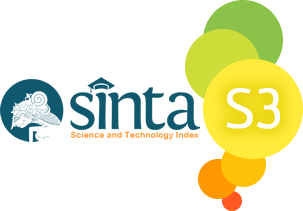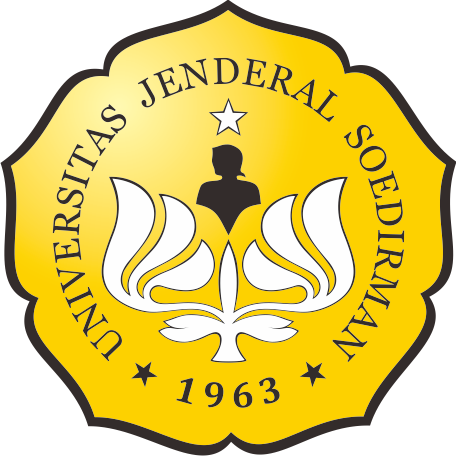PERUBAHAN KADAR PROTEIN DAN STATUS LIPOSTATIK IKAN SIDAT, Anguilla bicolor, STADIA SILVER YANG DIPELIHARA PADA SALINITAS YANG BERBEDA
Abstract
Eel (Anguilla bicolor) is a catradomous fish, in the growth phase of life in freshwater and upon reaching adult will migrate to ocean waters to reproduce. Eel during the migration will use energy from body reserves to osmoregulation. Increased salinity will affect the osmotic pressure of the body of the fish so that the fish do active transport which requires energy. Energy that used for osmoregulation approximately 20–50% of the total energy from carbohydrates, fats and proteins. Carbohydrates are the first source of energy that is used and then will be replaced by fat and protein as energy after carbohydrate depleted. Thus the energy utilization during osmoregulation will affect the changes in the composition of protein and fat content of the body. Fat content will affect the value of lipostatic fish is one of the growth parameters. The purpose of this study was to evaluate changes in the levels of protein and lipostatic eel (Anguilla bicolor) is maintained in a range of salinity. This research method is experimental research design with CRD, treatment in the form of maintenance medium salinity; 4 ppt (control), 15 ppt, and 30 ppt. Each treatment was repeated 5 times. Test fish used were obtained from the Village Pesanggrahan Cilacap with range size between an average weight of 395–920 g and an average length of 59–81 cm. The variables measured were the levels of protein and lipostatic eel. Protein content measurement was conducted using kjeldahl and the fat content by soxhlet. Research results showed that the eels were exposed to salinity 4 ppt, 15 ppt and 30 ppt no effect on protein content and body lipostatic eel. It can be concluded that the eel is able to adapt well in the range between 4 ppt salinity to 30 ppt.
Keywords
Full Text:
PDFReferences
AOAC (Association of Official Analitycal Chemists). 1990. Official Methods of Analysis, 12th Edition. Washington, D. C: Association of Official Analytical Chemists. 1141 p.
AOAC (Association of Official Analytical Chemist). 2005. Official Methods of Analysis. Washington: Association of Official Analytical Chemists. AOAC Arlington.
Ballarin JD, Haller RD. 1982. The Intensive Culture of Tilapia in Tank, Raceways and Cages. In J.F. Muir. R.J. Roberts (eds). Recent Advances in Aquaculture. Colorado: Westview Press.
Bone Q, Richard HM. 2008. Biology Of Fishes, Third Edition. New York : Taylor & Francis Group.
Czesny S, Rinchard J, Garcia Abiado MA, Dabrowski K. 2003. The Effect of Fasting, Prolonged Swimming, And Predator Presence On Energy Utilization And Stress In Juvenile Walleye (Stizostedion vitreum). Journal Elsevier Physiology and Behaviour. 79(3): 597-603. https://doi.org/10.1016/S0031-9384(03)00124-0
Darwisito S, Hengky JS, Indah W. 2015. Tingkat Perkembangan Gonad, Kualitas Telur, dan Ketahanan Hidup Larva Ikan Nila (Oreochromis niloticus) Berdasarkan Perbedaan Salinitas. 2015. Jurnal LPPM Bidang Sains dan Teknologi. 2(2): 86-94.
Fahmi MR. 2010. Phenotypic Platisity Kunci Sukses Adaptasi Ikan Migrasi: Studi Kasus Ikan Sidat (Anguilla sp.). Prosiding Forum Inovasi Teknologi Akuakutur. Depok: Balai Riset Budidaya Ikan Hias.
Fitria AS. 2012. Analisis Kelulushidupan da Pertumbuhan Benih Ikan Nila (Oreochromis niloticus) F5 D30-D70 Pada Berbagai Salinitas. Journal of Aquaculture Management and Technology. 1(1): 18-34.
Fujaya Y. 2004. Fisiologi ikan, Dasar pengembangan teknologi perikanan. Jakarta: Rineka Cipta.
Heinsbroek LTN, Stottrup JG, Jacobsen C, Corraze G, Kraiem MM, Holst L. K, Tomkiewicz J, Kaushik S. J. 2013. A Riview on Broodstock Nutrition of Marine Pelagic Spawners: The Curious Case of The Freshwater Eels (Anguilla spp.). Journal Aquacultur Nutrition, 19(3): 1-24. https://doi.org/10.1111/anu.12091
Holiday FGT. 1969. The Effect of Salinity on The Eggs and Larvae of Teleostei. Di dalam: Hoar WS and Randall DJ, editor. Fish Physiology. New York. I. Academic Press.
Irawan RSD. 2006. Perubahan Komposisi Karkas dan Model Lipostatik Ikan Kerapu Lumpur (Epinephelus tanvina) Sebagai Respon Terhadap Restriksi Pakan Secara Periodik di Tambak Cilacap. [Skripsi]. Purwokerto: Fakultas Biologi Universitas Jenderal Soedirman.
Laiz CR, Sangiao AS, Guzmán JM, Martin Del Rio MP, Soengas JL, Mancera J. 2005. Growth Performance of Gilthead Sea Bream in Different Osmotic Conditions: Implications for Osmoregulation and Energy Metabolism. Aquaculture. 250(3): 849–861. https://doi.org/10.1016/j.aquaculture.2005.05.021
Lisboa V, Barcarolli IF, Sampaio LA, Bianchini A. 2015. Effect of Salinity on Survival, Growth and Biochemical Parameters in Juvenile Lebranch mullet Mugil liza (Perciformes: Mugilidae). Neotropical Ichthyology. 13(2): 447–452. https://doi.org/10.1590/1982-0224-20140122
Lucas MC, Baras E. 2001. Migration of Freshwater Fishes. London: Blackwell Science. https://doi.org/10.1002/9780470999653
Jalali M, Reza D, Abdul AM, Sayed AMZ. 2013. A Comparative Study on Body Composition of Shyrbot (Barbus grypus) Fish Reared in Different Salinities. Elixir International Journal. 60(3): 16318-16320.
Mommsen TP, Vijayan MM, Moon TW. 1999. Cortisol in Teleosts: Dynamics, Mechanisms of Action, and Metabolic Regulation. Rev. Fish Biol. Fish. 9(3): 211–268. https://doi.org/10.1023/A:1008924418720
Murray RK, Granner DK, Mayes PA, Rodwell VW. 2003. Biokimia Harper, Edisi XXV, Penerjemah Hartono Andry. Jakarta: ECG.
Napitupulu, Romauli J, Heni B. 2011. Pengolahan Ikan Sidat. Modul Penyuluhan Perikanan. pp.1-52.
NRC. 1993. Nutrient Requirement of Warm Water Fishes and Shelfish. Washington DC: Nutritional Academy of Science.
Pramono SB. 2006. Efek Konsentrasi Kromium (Cr+3) dan Salinita Berbeda terhadap Efisiensi Pemanfaatan Pakan untuk Pertumbuhan Ikan Nila (Oreochromis niloticus). [Tesis]. Semarang: Pascasarjana Universitas Diponegoro.
Pérez RJ, Re AD, Giffard MI, Díaz F. 2011. Interactive Effects of Salinity on Oxygen Consumption, Ammonium Excretion, Osmoregulation and Na+/K+-ATPase Expression in Bullseye Puffer (Sphoeroides annulatus, Jenyns 1842). Aquaculture Research. 43(9): 1372–1383. https://doi.org/10.1111/j.1365-2109.2011.02940.x
Plaut I. 2000. Resting Metabolic Rate, Critical Swimming Speed, and Routine Activity of the Euryhaline Cyprinodontid, Aphanius dispar, Acclimated to A Wide Range od Salinities. Journal Physiological and Biochemical Zoology. 73(5): 590-596. https://doi.org/10.1086/317746
Purwanto J. 2007. Pemeliharaan Benih Ikan Sidat (Anguilla bicolor) dengan Padat Tebar yang Berbeda. Balai Besar Pengembangan Budidaya Air Tawar. Sukabumi. Bul.Tek.Lit. akuakuktur. 6(2).
Rinindar MI, Tia ZB, Abdul H, Sugito, Herrialfian. 2015. Analisis Proksimat Kadar Lemak Ikan Nila yang Diberi Suplementasi Daun Jaloh yang Dikombinasikan dengan Kromium dalam Pakan setelah Pemaparan Stres Panas. Jurnal Medika Veterinaria. 9(1), pp. 60-63.
Steel RGD, Torrie JH. 1981. Principle and Procedure of Statistics. 2nd Ed. London. McGraw Hill, International Book Company.
Stickney RR. 1979. Principle of Warmwater Aquaculture. John Willey and Sons Inc., New York.
Sukardi P, Yuwono, E. 2010. Nutrisi Ikan. UPT Percetakan dan Penerbitan Universitas Jenderal Soedirman. Purwokerto.
Wulandari AR. 2006. Peranan Salinitas terhadap Kelangsungan Hidup dan Pertumbuhan Benih Ikan Bawal Air Tawar Colossoma macropomum. [Skripsi]. Institut Pertanian Bogor. Bogor.
Zonneveld N, Huisman EA, Boon JH. 1991. Prinsip-prinsip Budidaya Ikan. Gramedia. Jakarta.
Article Reads
Total: 2953 Abstract: 1823 PDF: 1130Refbacks
- There are currently no refbacks.

This work is licensed under a Creative Commons Attribution-ShareAlike 4.0 International License.
This website is maintained by:
Bio Publisher
The Faculty of Biology Publishing
Faculty of Biology
Universitas Jenderal Soedirman
Jalan dr. Suparno 63 Grendeng
Purwokerto 53122
Telephone: +62-281-625865
Email: biologi@unsoed.ac.id
T his website uses:
OJS | Open Journal System
A free journal management and publishing system that has been developed by the PKP (Public Knowledge Project) version 2.4.8.0.
All article content metadata are registered to:
Crossref
An official nonprofit Registration Agency of the International Digital Object Identifier (DOI) Foundation.
Articles in this journal are indexed by:









